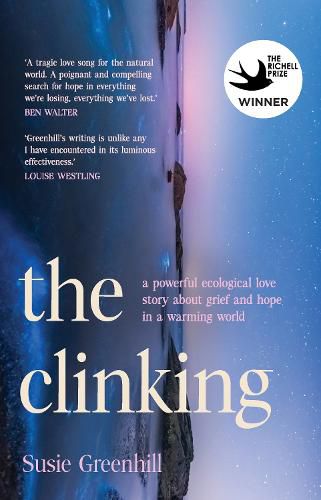The Clinking by Susie Greenhill

The clinking is Tasmanian Richell Prize (2016) prize-winner Susie Greenhill's debut novel. This book feels like a heart-felt cry. It feels like the author is intimately aware of the natural world as one who has lived close, camped and hiked often in the wilderness and perhaps worked alongside or known well, people whose lived experience is the environmental sciences. Author Susie Greenhill lives on the mouth of the Huon River in southern Tasmania. This probably explains the understanding of that environment that spans years and geographic locations. The clinking is a harrowing read with social, economic and political structures and their impact on the environment and the people who work trying to preserve the environment bleeding through the story. Through the character of Tom, an ecologist working on extinctions, we see the battles for funding and recognition of the seriousness of findings and the lack of action on part of government.
The clinking is a story of a young family. Tom, his wife Elena and their daughter Orla are decent people. We see Tom and Elena falling in love, dreaming, struggling and doomed. Elena is full of life and hope for the future. Tom can't see a future in which to raise children. As a scientist he has seen the differing processes that have been tried to save species (both plant and animal) including adaptation, mitigation and prevention but daily he sees the unravelling. Although he is seeing a counsellor he is sinking into clinical depression. Despite his love for his little family, Tom becomes increasingly consumed by the hopelessness of trying to fight to maintain species and the tipping towards complete destruction of the Earth. Temperamentally not suited to this work, he becomes consumed and emotionally, psychologically and finally literally lost. Against an imploding societal breakdown and on the brink of a dystopian future Tasmania, Elena, Orla and their friend Kit search for Tom in the remote south-western wilderness. Leaving a nightmarish imagined future - a collapsing and dangerous Hobart where the thin veneer of human civilisation is collapsing, they set out on a quest to find answers in an old yacht in a nearly frozen lake. Government schemes that have destroyed the Tasmanian environment are a constant meta-narrative throughout and Lake Pedder, submerged in 1972 by the Hydro Electric Commissions, despite having National Park protection status figures large and is probably the destination for the search.
Italicised sections at the beginning of each chapter are actually "Endlings" (surely the saddest and loneliest word) because it describes the moment when the last of each species dies alone. Different worldwide scenarios are described beginning with the lost "clinking" of the abalone, the loss of the pelagic fish and shark species in the Andaman Sea, of Takayna river myrtle, of moths, of groundwater, of glaciers, of cranes near the Bering Sea, of whales, of human homes due to rising sea levels in the Pacific, of Boreal forests and permafrost, of the thylacine and etc. At first the "endlings" prefacing each chapter seem disconnected but they start to become a type of tolling bell and underlying witness to the unfolding narrative.
The clinking is a novel about loss - of the environment and humanity aswell. Elena is herself a human refugee. People are becoming refugees looking for rehoming like the Tasmanian devils being repatriated on offshore islands. Rich people and doomsday preppers are building bunkers - escape homes in the wilderness (with arsenals of guns) while the poor are swallowed up in violence and hunger. There is so much loss and grief in Tom and Elena's life.
Amongst the loss though there is beauty and decency. The description of Kit, the family friend, is one example of Greenhill's ability to evoke decency of behaviour between human beings. Her respect for nature is apparent in the detailed descriptions of small objects such as birds, feathers and eggs and in the sensory nature of her writing. Take any page and the lyrical descriptions appear eg. "...a pair of tiny fire-tailed finches sifted for seeds and insects...hopping lightly back and forth... their scarlet beaks rustling softly in the curled brown leaves of the blackwood... a high clear call...of spring afternoons in their forest...Orla twisting the tyre swing from a limb of the horse-chestnut..." A powerful metaphor and symbol is the lily - fragile but surviving and representing hope. Orla is told that if they go back to the lake again it may still be there.
The Clinking is lyrical and luminescent. The clinking is an appropriate title which goes to the heart and bookends the narrative. It's a calling for life from heart wrenching sadness to fragile hope. Much of the wisdom is encapsulated by Tom when he tells Orla that humans are alright, that governments and companies have been doing things that are "messed up", that some humans are so rich and powerful and others have nothing, that there's a way that sustains life and a way that doesn't..."In general you should choose the way that does, if you can."
The clinking is a worthwhile eco-fiction read. The world that it depicts is not full-on dystopian but scarier as it depicts a world on the brink.The escape/search aspect of the clinking is reminiscent of Dog Runner by Bren MacDibble. A thoroughly depressing but also desperately hopeful book; a battle between hope and despair is presented. It is uncertain which wins. The reader's response will be a mixture of fear, hope and bafflement as we wonder whether beautiful, creative and good intentions are just naive and whether corruption will win out.
This reader chooses to see The clinking as a warning and an offering of beautiful but fragile hope.
Themes: Environment, Eco-dystopia, Grief, Loss, Suicide, Depression, Still-birth, Species decline.
Wendy Jeffrey